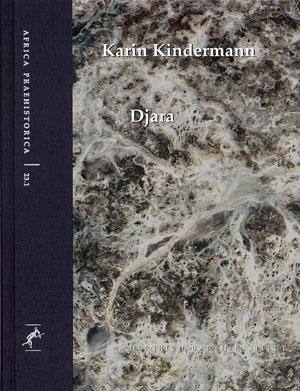
Africa Praehistorica 23, Köln 2010
Karin Kindermann:
Djara. Zur mittelholozänen Besiedlungsgeschichte zwischen Niltal und Oasen (Abu-Muharik-Plateau, Ägypten) – Teil 1
Karin Kindermann:
Djara. Zur mittelholozänen Besiedlungsgeschichte zwischen Niltal und Oasen (Abu-Muharik-Plateau, Ägypten) – Teil 2
(Beiträge von Erich Claßen, Frank Darius, Stefanie Nussbaum, Andreas Pastoors, Nadja Pöllath, Heiko Riemer und Peter Schönfeld)
- 860 pp.
- 248 figures
- 150 bw. photographs, 6 colour photograph / 2 colour plates
- 28 maps
- 142 tables
- English, French and Arabic summaries
- hardcover, half linen-bound, size 21 x 28 cm
ISBN 978-3-927688-35-3
Archaeological excavations and surveys at Djara, which lies in the centre of the Egyptian Limestone Plateau between the Nile Valley and the oases of Egypt‘s Western Desert (Abu Muhariq Plateau), have revealed more than 200 archaeological sites that predominantly date back to the mid-Holocene humid phase, c. 6500-5200 BC. During that time, hunter-gatherers used the plateau desert as a temporal habitation area preferably during the winter season, when wild seeds could be gathered and gazelles were hunted after the winter rains.
Part 1 of the publication presents Karin Kindermann’s PhD thesis which includes the chronological sequence of Djara based on the lithic development and radiocarbon dates; the reconstruction of the seasonal cycle of the prehistoric people at Djara on the basis of archaeological data and ethnographical parallels; as well as how the Saharan climatic drying around 5000 BC and the resulting migrational shift into the Nile Valley impacted on the formation of the early Predynastic cultures along the Nile.
Part 2 consists of a number of expert studies written by different authors: The archaeological survey at Abu Gerara and in other areas south of Djara; the examination of the prehistoric pottery from Djara and Abu Gerara; the complete rock art recording from the Djara dripstone cave; the archaeobotanical and environmental evidence; as well as the archaeozoological analysis. Two papers are written English, while Kindermann’s contribution as well as three other papers are in German, with extended English summaries.